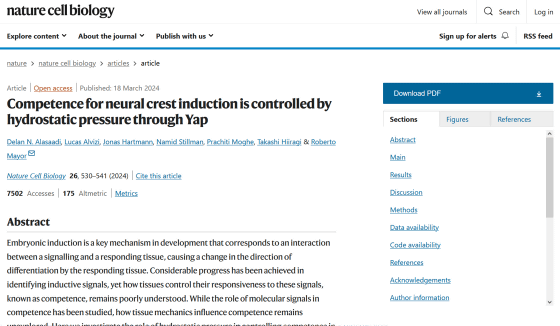Research suggests that human faces may be shaped by pressure in the womb

You might think that
Competence for neural crest induction is controlled by hydrostatic pressure through Yap | Nature Cell Biology
https://www.nature.com/articles/s41556-024-01378-y

Pressure in the womb may influence facial development | UCL News - UCL – University College London
https://www.ucl.ac.uk/news/2024/apr/pressure-womb-may-influence-facial-development
Your Face May Have Been Shaped by Pressure in The Womb, Study Finds: ScienceAlert
https://www.sciencealert.com/your-face-may-have-been-shaped-by-pressure-in-the-womb-study-finds
In humans, a fertilized egg undergoes repeated cell division to become a ball called a blastocyst , which then implants in the mother's uterus and becomes a fetus, where the various structures that make up a human develop. A 2020 study revealed that the membrane that covers the fetus during early pregnancy plays a role in protecting the fetus from the pressure of the uterus, suggesting that fetal development is influenced not only by genetic factors but also by other external factors.
In this study, the research team applied external pressure to human embryoid bodies made by combining mouse and frog embryos, as well as human embryonic cells, to investigate in detail how different pressures affect embryo development.
The results of the experiment showed that applying higher than normal levels of pressure to embryos or human embryoid bodies disrupts the cell signaling pathways of neural crest cells , which differentiate into bone, cartilage, nerve cells, etc. Since the various parts of the face are derived from neural crest cells, if the cell signaling pathways of neural crest cells are disrupted by increased pressure in the womb, there is a risk of facial deformities.

The research team's analysis showed that when pressure is applied to the blastocyst cavity , near where the neural crest tissue develops, the activity of a protein called YAP , which functions as a gene transcription factor, is reduced, impairing the Wnt signaling pathway, a cell signaling pathway.
While most studies have looked at biochemical factors affecting embryo development, this study provides new insight into the influence of mechanical factors on embryo development. 'Our findings suggest that facial deformities may be influenced not only by genetics, but also by physical cues such as pressure in the womb,' said Roberto Mayer , a neurobiologist at University College London. 'When an organism experiences a change in pressure, all cells in the mother's body can sense it, including the embryo.'
Although this study revealed that pressure changes in the womb reduce the efficiency of neural crest cell signaling, it is unclear to what extent this affects the fetus. 'Further research is needed to understand how changes in the body and environmental pressures affect human embryo development,' said Mayer.
Related Posts:
in Science, Posted by log1h_ik







